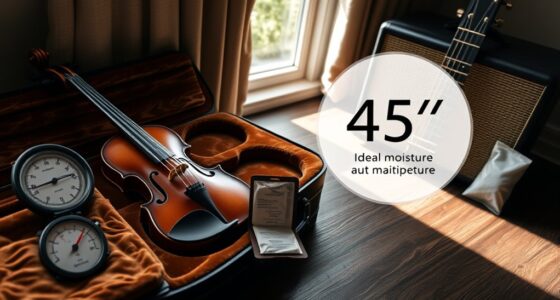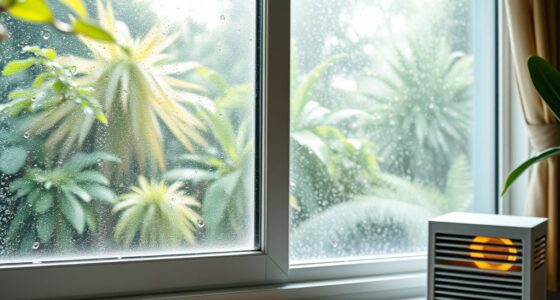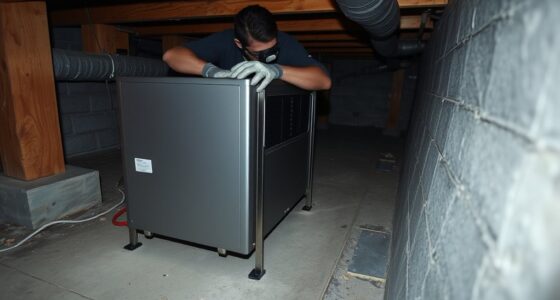Choosing between portable and whole-house dehumidifiers depends on your space size, humidity needs, and budget. Portable units are inexpensive, easy to use, and perfect for small to medium rooms, while whole-house systems are ideal for larger spaces or entire homes, offering consistent humidity control. If you want flexibility and quick setup, go portable. For permanent, integrated solutions, a whole-house dehumidifier is better. To make the best choice, explore more details ahead.
Key Takeaways
- Portable dehumidifiers are ideal for small to medium rooms, while whole-house models cover larger spaces and entire homes.
- Portable units are easier to install and move, whereas whole-house systems require professional integration with HVAC.
- Portable dehumidifiers are cost-effective for quick fixes, but whole-house systems, though more expensive, offer long-term energy efficiency.
- Choose portable units for localized control; opt for whole-house systems for consistent humidity management throughout your property.
- Consider your space size, budget, and maintenance preferences to determine whether a portable or whole-house dehumidifier best suits your needs.

When choosing a dehumidifier, understanding the differences between portable and whole-house models can help you make the right decision for your space. One of the key factors to consider is energy efficiency. Portable dehumidifiers generally consume less power per hour because they’re designed to target a specific area, making them ideal for small to medium rooms. They often have adjustable settings to optimize energy use, helping you control humidity without wasting electricity. Whole-house dehumidifiers, on the other hand, are built to handle larger spaces and can be more energy-efficient on a per-square-foot basis if you need to dehumidify an entire home. Since they work with your existing HVAC system, they can operate continuously with less energy loss, especially if designed with high-efficiency compressors and fans.
Portable dehumidifiers are energy-efficient for small spaces, while whole-house systems excel in larger areas with integrated HVAC compatibility.
Another crucial aspect is the installation process. Portable dehumidifiers are straightforward: you simply plug them in, fill their water tank, and turn them on. They require no professional help and can be moved from room to room, giving you flexibility. This makes them an attractive choice if you want a quick, easy solution or if you’re renting and cannot make permanent modifications. Whole-house dehumidifiers, however, involve a more complex installation process. They typically require integration with your home’s HVAC system, which may involve ductwork, electrical wiring, and professional installation. This initial setup can be time-consuming and costly, but it results in a more seamless and permanent solution that maintains consistent humidity levels throughout your entire home. Understanding support hours for these systems can also help you plan maintenance and troubleshooting.
In terms of energy efficiency, whole-house systems often have the advantage because they are designed to work continuously and are optimized for larger spaces. Their capacity to dehumidify the entire house with a single unit also reduces the need to run multiple portable units, saving energy overall. Conversely, portable units are more efficient for localized control and small spaces but can become less economical if you need to dehumidify multiple rooms simultaneously. For homeowners who want a quick fix and flexibility, portable models are a practical choice. But if you’re seeking a long-term, integrated solution that handles humidity across your entire property, investing in a whole-house dehumidifier, despite the higher upfront costs and installation process, could be more beneficial and energy-efficient in the long run.
Ultimately, your decision hinges on your specific needs, budget, and willingness to undertake installation. Contemplate how much space you need to dehumidify, your energy consumption priorities, and whether you prefer a portable unit or a built-in system for comprehensive control.
Frequently Asked Questions
How Much Energy Does Each Type Typically Consume?
You’re wondering about how much energy each dehumidifier type uses. Portable models generally consume less power, making them more energy-efficient for small spaces. Whole-house units tend to have higher power consumption because they handle larger areas, but they often feature better energy efficiency features. Consider your needs and energy efficiency ratings to find a balance, ensuring you minimize power consumption while effectively controlling humidity in your home.
Can Portable Dehumidifiers Handle Large Spaces Effectively?
While portable dehumidifiers excel in small rooms, they struggle with large spaces. You might find their limited humidity capacity inadequate for big areas, leading to uneven moisture control. For effective dehumidification in large spaces, you need a unit with higher humidity capacity or consider a whole-house system. So, if your room size is extensive, a portable dehumidifier alone probably won’t handle it effectively.
What Maintenance Is Required for Each Dehumidifier Type?
You need to maintain your dehumidifiers regularly to keep them running efficiently. For portable units, check humidity sensors often and clean or replace filters as needed to prevent mold and dust buildup. Whole-house systems require professional inspections and filter replacements periodically. Both types benefit from keeping sensors clean for accurate humidity control. Regular maintenance ensures peak performance, prolongs lifespan, and maintains a healthy indoor environment.
Are Portable Units Suitable for Basements?
Imagine your basement turning into a swamp, with moisture so stubborn it laughs at your efforts. Portable units can help tame basement moisture, but they’re like tiny fire trucks fighting a forest fire. They work well if you have good ventilation options, but might struggle with larger spaces. For persistent moisture issues, a more robust solution might be needed. Still, for small, damp corners, portable dehumidifiers are a handy, if modest, fix.
How Do Costs Compare Over the Long Term?
When comparing long-term costs, portable dehumidifiers often have lower initial purchase affordability but may cost more to operate over time due to higher energy consumption. Whole-house units typically require a bigger upfront investment but offer better cost efficiency with lower energy use and less maintenance. You’ll want to contemplate your space and humidity needs to determine which option balances purchase affordability with ongoing operational savings.
Conclusion
Choosing between portable and whole-house dehumidifiers is like picking the right tool for a job. Portable units are your quick, nimble sprinters, perfect for small spaces or targeted relief. Whole-house systems act like a sturdy bridge, supporting your entire home’s comfort. Consider your needs carefully—whether you need a quick fix or a reliable, all-encompassing solution. Whichever you choose, you’ll be steering your home’s humidity toward the perfect balance, creating a healthier, more comfortable space.









